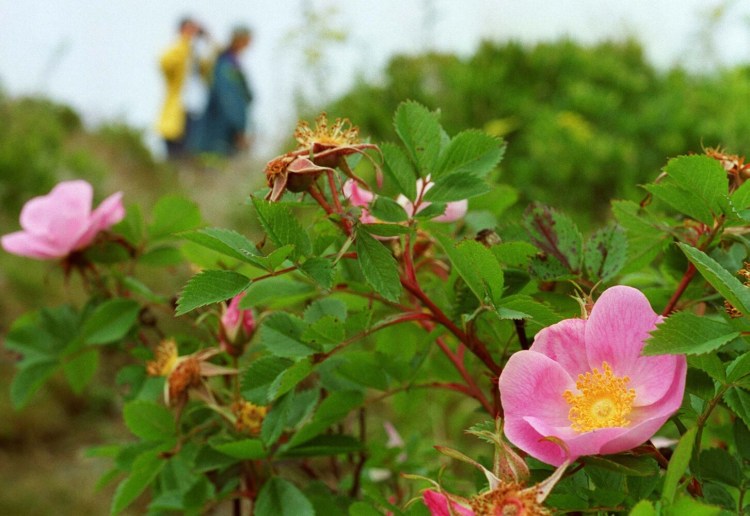Under a proposed list of plant species that could become illegal to import to or sell in the state, Mainers would lose out on some popular landscape plants – but that’s probably a good thing.
Several highly popular trees, shrubs and perennials are included on that list of 63 species. Many of the others, however, I’d never even heard of before.
The stakeholder committee that is charged with coming up with the plants to be banned plans to finalize its list on Jan. 18, according to State Horticulturist Gary Fish. The new list will be added to the 33 plants prohibited about five years ago. The state bans the sale and import of plants that spread rapidly and outcompete native plants, which over millennia have co-evolved with native fauna to provide critical shelter and food.

Apparently, vinca, or common periwinkle, is invasive. The state is considering banning it from import or sale. Photo by Peggy Grodinsky
Rugosa rose, the fragrant beach rose prevalent all along the coast and highly popular in gardens throughout Maine, is included. Other species on the list as it now stands are wisterias, vinca (aka periwinkle), Japanese tree lilac, Callery or ‘Bradford’ pear, Buddleia davidii (aka butterfly bush), hardy kiwi and Spirea japonica; that last includes the popular cultivar “Magic Carpet.”
When I interviewed Fish last summer shortly after the committee – which is made up of professionals in the landscape industry – began its work, he predicted rugosa rose would not make the list. I wondered what had changed.
“I think it’s because a couple of new (scientific) papers have been published about rugosa roses showing up on offshore islands in the Netherlands,” Fish said.
Rosa rugosa are native to Asia. They were introduced to America in the mid-19th century, about the time of the Civil War. It turns out that rose hips – the orange-red fruit that contains the plant’s seeds – have fallen into the ocean, and floated long distances to form colonies on islands. Botanists along the Maine coast and in Canada have also reported such spread.
And Fish noted that the Maine Natural Areas Program, a state conservation program that the committee relies on when drawing up its list of banned plants, has long considered rugosa rose a highly invasive plant.
Fish singled out the Japanese tree lilac as another plant on the proposed list that is a regular seller at local nurseries. The tree lilac is related to, but different from, the common lilac found in many people’s gardens, which is native to Europe and is not affected by the ban.
Buddleia also sells well in Maine, but don’t be confused by its common name, butterfly bush. Buddleia is unrelated to Asclepias tuberosa, the misnamed butterfly weed, which is native to Maine and a host for monarch butterflies, whose numbers are in steep decline.
I was surprised to find periwinkle, or vinca minor, on the list. Decades ago, my wife, Nancy, and I planted both the white- and purple-flowered versions of the ground cover and I’ve even recommended it in this column as a good ground cover. We have had to cut it back occasionally to keep it from spreading on to our lawn, but we haven’t seen it seeding long distances from where we planted it. But, as I have learned about unrelated topics over the past couple of years, we have to trust the science.
Another point: The rules for the original 33 plants and the proposed 63 additional species ban only the sale or import of the plants. Homeowners who already grow them in their gardens are not required to get rid of them. That said, removal might be something to consider.
Early on, the stakeholder committee made the decision to exclude “hitchhiker plants” from the list, Fish said. Had it included those, the list would have extended to 30 additional species. Nurseries do not intentionally sell so-called hitchhiker plants; rather, they show up in the soil along with the plants that customers intend to buy.
At some point after the committee’s Jan. 18 vote on a final list, possibly in February, the proposal will be publicized, and the 30-day period for public comments will begin. The list will then go to commissioner of the Department of Agriculture, Conservation and Forestry and the Attorney General’s office, so they can approve the language.
The new regulations, once finalized, allow for a transition period of one or two years so that plant nurseries can sell any newly banned plants they have on hand. To enforce the bans, assistant state horticulturists visit all the commercial outlets selling plants over the course of a year. Enforcing the existing law has not been problematic, Fish said. A couple of chain stores were found selling euonymus (burning bush) and honeysuckle, but the plants were removed.
I went through the entire list of plants that would be banned under the new proposal, and I don’t think Maine gardeners will suffer from not being able to use them. Many gardeners are shifting to native plants, anyway. And there are many non-natives without harmful side effects.
Tom Atwell is a freelance writer gardening in Cape Elizabeth. He can be contacted at: tomatwell@me.com.
Send questions/comments to the editors.



Success. Please wait for the page to reload. If the page does not reload within 5 seconds, please refresh the page.
Enter your email and password to access comments.
Hi, to comment on stories you must . This profile is in addition to your subscription and website login.
Already have a commenting profile? .
Invalid username/password.
Please check your email to confirm and complete your registration.
Only subscribers are eligible to post comments. Please subscribe or login first for digital access. Here’s why.
Use the form below to reset your password. When you've submitted your account email, we will send an email with a reset code.